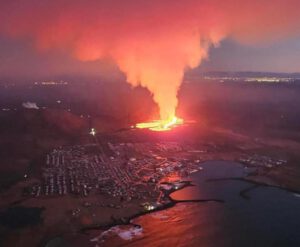 The expected volcanic eruption began this morning on Iceland’s Reykjanes Peninsula. A 900 m long eruption fissure opened 2 km north of Grindavik. Lava fountains along the fissure fed a lava flow that flowed in a southwesterly direction. In the afternoon a 1 m long fissure appeared on the outskirts of Grindavik. It is about 200 m from the nearest building. In the late afternoon a lava flow reached the first two houses. They burned down. At night the lava output decreased again. The eruption was preceded by a swarm earthquake lasting several hours. Significant ground uplift has been noted since the last eruption in December.
The expected volcanic eruption began this morning on Iceland’s Reykjanes Peninsula. A 900 m long eruption fissure opened 2 km north of Grindavik. Lava fountains along the fissure fed a lava flow that flowed in a southwesterly direction. In the afternoon a 1 m long fissure appeared on the outskirts of Grindavik. It is about 200 m from the nearest building. In the late afternoon a lava flow reached the first two houses. They burned down. At night the lava output decreased again. The eruption was preceded by a swarm earthquake lasting several hours. Significant ground uplift has been noted since the last eruption in December.
Eruptions
News about eruptions and volcanoes can be found in this category. It is updated frequently. Volcano expert and journalist Marc Szeglat reports live from his expeditions to volcanoes.
Iceland: Eruption started suddenly
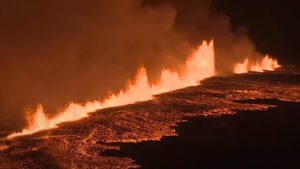 The long-awaited eruption began on Iceland’s Reykjanes Peninsula yesterday evening. At 10:17 p.m. an approximately 4 km long eruption fissure opens between Stóra-Skógfell and the old Sundhnúkar crater series. Lava fountains shoot up to 100 m high. The delivery rate is estimated at 100 – 200 cubic meters per second. The flow speed is just under 1 km per hour. The distance from the southern end to the outskirts of Grindavík is almost 3 km.
The long-awaited eruption began on Iceland’s Reykjanes Peninsula yesterday evening. At 10:17 p.m. an approximately 4 km long eruption fissure opens between Stóra-Skógfell and the old Sundhnúkar crater series. Lava fountains shoot up to 100 m high. The delivery rate is estimated at 100 – 200 cubic meters per second. The flow speed is just under 1 km per hour. The distance from the southern end to the outskirts of Grindavík is almost 3 km.
The volcanic eruption was preceded by a seismic crisis that began 90 minutes before the eruption. The IMO tables show 538 shocks, the period again being 48 hours. A good 300 earthquakes occurred immediately before the eruption. If you look at the size of the fissure, there were very few earthquakes and the warning time was short. It can be assumed that the melt was less than 1 km below the surface. It had already risen to this depth shortly after the dyke intrusion on November 10th. Apparently later, the volcanologists’ assessments were incorrect that most of the melt in the dyke had solidified after just 2-3 weeks. There were probably no measurable magma movements because the pressure in the dyke was too great.
Stromboli with stronger eruption
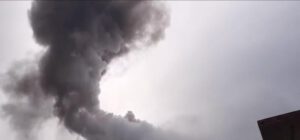 Yesterday, there was an eruption at the Sicilian island volcano Stromboli that was larger than normal. Footage shared on social media depicts an ash cloud drifting southward above the volcano. A stronger explosion signal is evident in the seismic activity. However, the explosion wasn’t strong enough to prompt the INGV to issue an extraordinary bulletin. Yesterday, the LGS confirmed that the emission of carbon dioxide was high, with over 1100 tons of this odorless gas being emitted. Most other geophysical measurement values remained at a moderate activity level, except for the sound pressure generated during the typical Strombolian eruptions, which was classified as low, measuring 0.26 bar. The volcanic activity was characterized by Strombolian explosions and degassing activities in the northeastern and southwestern sectors of the crater. The increased carbon dioxide emission suggests an increased ascent of magma from depth. A similar signal is coming from deep earthquakes in the asthenosphere region, which have been increasingly recorded in recent days. In a few months, we could therefore experience another phase of lava activity at Stromboli.
Yesterday, there was an eruption at the Sicilian island volcano Stromboli that was larger than normal. Footage shared on social media depicts an ash cloud drifting southward above the volcano. A stronger explosion signal is evident in the seismic activity. However, the explosion wasn’t strong enough to prompt the INGV to issue an extraordinary bulletin. Yesterday, the LGS confirmed that the emission of carbon dioxide was high, with over 1100 tons of this odorless gas being emitted. Most other geophysical measurement values remained at a moderate activity level, except for the sound pressure generated during the typical Strombolian eruptions, which was classified as low, measuring 0.26 bar. The volcanic activity was characterized by Strombolian explosions and degassing activities in the northeastern and southwestern sectors of the crater. The increased carbon dioxide emission suggests an increased ascent of magma from depth. A similar signal is coming from deep earthquakes in the asthenosphere region, which have been increasingly recorded in recent days. In a few months, we could therefore experience another phase of lava activity at Stromboli.
Earthquake caused by magma intrusion near Grindavik on Iceland
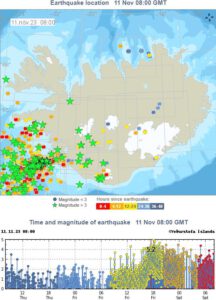 There has been a strong swarm earthquake under Iceland’s Reykjanes Peninsula since October 25th. Several tremors had magnitudes in the region of five. The earthquakes were triggered by an accumulation of magma at a depth of 4-5 km and the ground rose. At the center of this uplift was the area around the Thorbjörn volcano near Svartsengi. On Friday November 10th, activity increased significantly and a dyke formed. It is 15 km long and runs from Kálffellsheiði on the northwest edge of Fagradalsfjall to under the sea near Grindavik. The place was evacuated because a major volcanic eruption is expected in the next few days.
There has been a strong swarm earthquake under Iceland’s Reykjanes Peninsula since October 25th. Several tremors had magnitudes in the region of five. The earthquakes were triggered by an accumulation of magma at a depth of 4-5 km and the ground rose. At the center of this uplift was the area around the Thorbjörn volcano near Svartsengi. On Friday November 10th, activity increased significantly and a dyke formed. It is 15 km long and runs from Kálffellsheiði on the northwest edge of Fagradalsfjall to under the sea near Grindavik. The place was evacuated because a major volcanic eruption is expected in the next few days.
Access to the area was cordoned off over a large area and a no-fly zone for drones was set up.
Lewotolok erupts ash clouds and glowing tephra
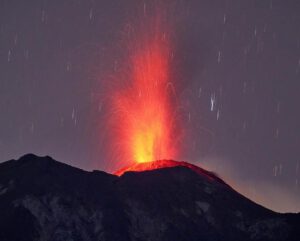 The Lewotolok is a 1431-meter-high stratovolcano located on the Indonesian island of Lembata. It has been active for nearly three years, with only a few short periods of eruption pauses. During the summer, the eruptive activity was relatively low, with approximately 10 strombolian eruptions recorded per day. In the past week, the activity has significantly increased, and yesterday, the VSI (Volcanological Survey of Indonesia) detected 107 eruptions. These eruptions generated seismic signals with maximum amplitudes of 38 mm and durations of up to 358 seconds. The number of volcanically-induced earthquakes also increased, with 26 volcanic-tectonic tremors recorded yesterday. Additionally, there were 17 tremor phases. There were 155 signals originating from strong degassing, which was more prevalent during weeks of low eruptive activity than it is now. Up to 400 of these signals were recorded per day.
The Lewotolok is a 1431-meter-high stratovolcano located on the Indonesian island of Lembata. It has been active for nearly three years, with only a few short periods of eruption pauses. During the summer, the eruptive activity was relatively low, with approximately 10 strombolian eruptions recorded per day. In the past week, the activity has significantly increased, and yesterday, the VSI (Volcanological Survey of Indonesia) detected 107 eruptions. These eruptions generated seismic signals with maximum amplitudes of 38 mm and durations of up to 358 seconds. The number of volcanically-induced earthquakes also increased, with 26 volcanic-tectonic tremors recorded yesterday. Additionally, there were 17 tremor phases. There were 155 signals originating from strong degassing, which was more prevalent during weeks of low eruptive activity than it is now. Up to 400 of these signals were recorded per day.
A new eruption began at Kilauea in Halema’uma’u Crater
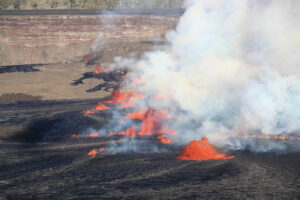 Yesterday afternoon, the Kilauea volcano erupted again. It started around 3:30 PM Hawaiian time when a 1400-meter-long eruption fissure opened in the summit caldera. It cut across the Halema’uma’u Crater and even intersected one of the blocks in the caldera that had subsided during the 2018 eruption. During the initial phase, lava fountains up to 50 meters high were produced. The lava quickly spread in the Halema’uma’u Crater, creating a large secondary lava lake that now covers most of the crater floor. An area noticeably higher than the rest of the flat crater floor remains uncovered. This area was active during the recent eruption and was built up by several layers of lava. Most of the activity along the eruption fissure has since ceased, with the majority of lava now bubbling up from a partial rift near the base of the crater wall, and some lava appears to be welling up in the opposite sector of the rift.
Yesterday afternoon, the Kilauea volcano erupted again. It started around 3:30 PM Hawaiian time when a 1400-meter-long eruption fissure opened in the summit caldera. It cut across the Halema’uma’u Crater and even intersected one of the blocks in the caldera that had subsided during the 2018 eruption. During the initial phase, lava fountains up to 50 meters high were produced. The lava quickly spread in the Halema’uma’u Crater, creating a large secondary lava lake that now covers most of the crater floor. An area noticeably higher than the rest of the flat crater floor remains uncovered. This area was active during the recent eruption and was built up by several layers of lava. Most of the activity along the eruption fissure has since ceased, with the majority of lava now bubbling up from a partial rift near the base of the crater wall, and some lava appears to be welling up in the opposite sector of the rift.
The volcanic eruption was not unexpected. For several weeks, there had been a significant increase in seismic activity, with daily records of between 150 and 200 minor tremors, primarily concentrated in an area south of the caldera. There were periods of significant ground uplift, which had subsided in the days leading up to the eruption. During that time, the magma that is erupting now had accumulated in a magmatic conduit.
Explosion at Shishaldin sends ash up to 9,700 meters in height
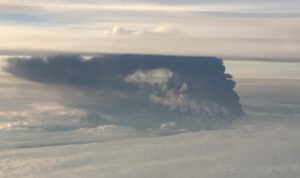 Yesterday afternoon, around 16:30 UTC (08:30 local time), an explosive eruption of the volcano Shishaldin began. It was preceded by several hours of increasing seismic activity. The explosion produced a large ash cloud that rose to an altitude of 9,700 meters and drifted southeastward over the sea. During the eruption, a high thermal radiation of 321 MW was recorded, indicating that not only volcanic ash but also red-hot lava was erupting. The eruption caused strong tremors, clearly visible on the seismogram.
Yesterday afternoon, around 16:30 UTC (08:30 local time), an explosive eruption of the volcano Shishaldin began. It was preceded by several hours of increasing seismic activity. The explosion produced a large ash cloud that rose to an altitude of 9,700 meters and drifted southeastward over the sea. During the eruption, a high thermal radiation of 321 MW was recorded, indicating that not only volcanic ash but also red-hot lava was erupting. The eruption caused strong tremors, clearly visible on the seismogram.
Half an hour later, seismic activity rapidly decreased, and the altitude of ash emissions observed by satellite also reduced to about 4,500 meters. By 20:00 UTC, the ash cloud had spread about 125 km in low altitude.
Shishaldin is a 2,857 m high stratovolcano on the Aleutian Island of Unimak. The Aleutians are a volcanic island arc connected to the Alaska Peninsula.
The seismicity at Mount Merapi is reaching new peak values.
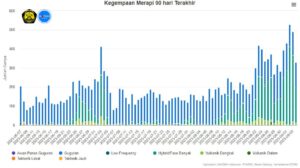 The seismic activity at Mount Merapi in Indonesia has reached new peak levels. On September 2nd, there were 407 hybrid earthquakes recorded, followed by approximately 348 of these tremors detected the following day. These are record values that are rarely reached and indicate fluid movements beneath the volcano. It is expected that the growth of the volcanic dome will continue in the coming days and could potentially intensify.
The seismic activity at Mount Merapi in Indonesia has reached new peak levels. On September 2nd, there were 407 hybrid earthquakes recorded, followed by approximately 348 of these tremors detected the following day. These are record values that are rarely reached and indicate fluid movements beneath the volcano. It is expected that the growth of the volcanic dome will continue in the coming days and could potentially intensify.
In addition to the numerous hybrid earthquakes, other volcano-tectonic tremors have also been detected. Yesterday, 129 seismic signals indicated rockfall avalanches, increasing the risk of pyroclastic flows.
In their latest weekly report, researchers from BPPTKG explain that there have been morphological changes in both domes growing inside the volcano’s crater. The most significant changes were observed in the southwestern dome. The volume of this dome was 2,858,600 cubic meters, compared to 2,764,300 cubic meters measured the previous week. Despite some reductions, the dome has slightly increased in size. The central dome, on the other hand, experienced a decrease in volume. It had a volume of 2,355,100 cubic meters, indicating potential collapses or shrinkage processes due to the cooling of the magma inside the dome.
Earthquakes in the Northwest of Mount Etna
Date: August 30, 2023 | Time: 16:28:00 UTC | Coordinates: 37.765, 14.939 | Depth: 21 km | Magnitude: Md 2.9
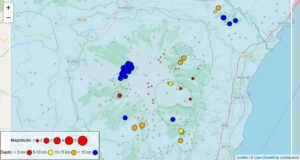 Today, on the INGV earthquake map, we can see an earthquake swarm that already occurred on August 30th. The earthquake sequence consisted of 13 tremors with magnitudes greater than 1. The strongest earthquake occurred at 16:28 UTC and reached a magnitude of Md 2.9. The hypocenter was located at a depth of 21 km, and the epicenter was identified as 1.4 km southwest of Monte Scavo, a wooded scoria cone in the northwest of Mount Etna. The nearest major town is Bronte. The weakest earthquake had a magnitude of 1.4 and had a similarly deep hypocenter as the strong earthquake. It is suspected that the earthquake swarm was triggered by magma rising in the upper part of the asthenosphere, on its way to penetrate the Earth’s crust. Earthquakes at this depth are more the exception than the rule, but it cannot be ruled out that they could have been purely tectonic in origin.
Today, on the INGV earthquake map, we can see an earthquake swarm that already occurred on August 30th. The earthquake sequence consisted of 13 tremors with magnitudes greater than 1. The strongest earthquake occurred at 16:28 UTC and reached a magnitude of Md 2.9. The hypocenter was located at a depth of 21 km, and the epicenter was identified as 1.4 km southwest of Monte Scavo, a wooded scoria cone in the northwest of Mount Etna. The nearest major town is Bronte. The weakest earthquake had a magnitude of 1.4 and had a similarly deep hypocenter as the strong earthquake. It is suspected that the earthquake swarm was triggered by magma rising in the upper part of the asthenosphere, on its way to penetrate the Earth’s crust. Earthquakes at this depth are more the exception than the rule, but it cannot be ruled out that they could have been purely tectonic in origin.
Ebeko erupts ash clouds up to 4000 meters in height
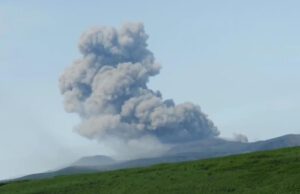 The volcano Ebeko on Paramushir has been active in the past two days, emitting ash clouds up to 4000 meters above sea level. These ash clouds have been drifting southeastward due to the wind. The KVERT observatory has confirmed the volcanic activity and reported weak thermal anomalies detected at the crater. It was noted that eruptions could occur at any time, causing ash clouds to rise to 3500 meters in height, posing a danger to low-flying aircraft. The aviation alert status is currently set to “orange.”
The volcano Ebeko on Paramushir has been active in the past two days, emitting ash clouds up to 4000 meters above sea level. These ash clouds have been drifting southeastward due to the wind. The KVERT observatory has confirmed the volcanic activity and reported weak thermal anomalies detected at the crater. It was noted that eruptions could occur at any time, causing ash clouds to rise to 3500 meters in height, posing a danger to low-flying aircraft. The aviation alert status is currently set to “orange.”